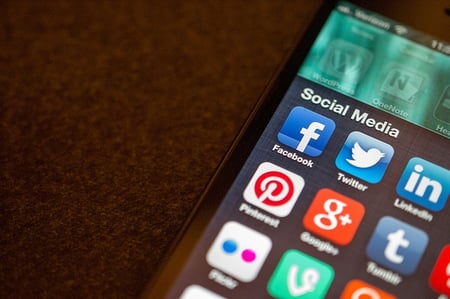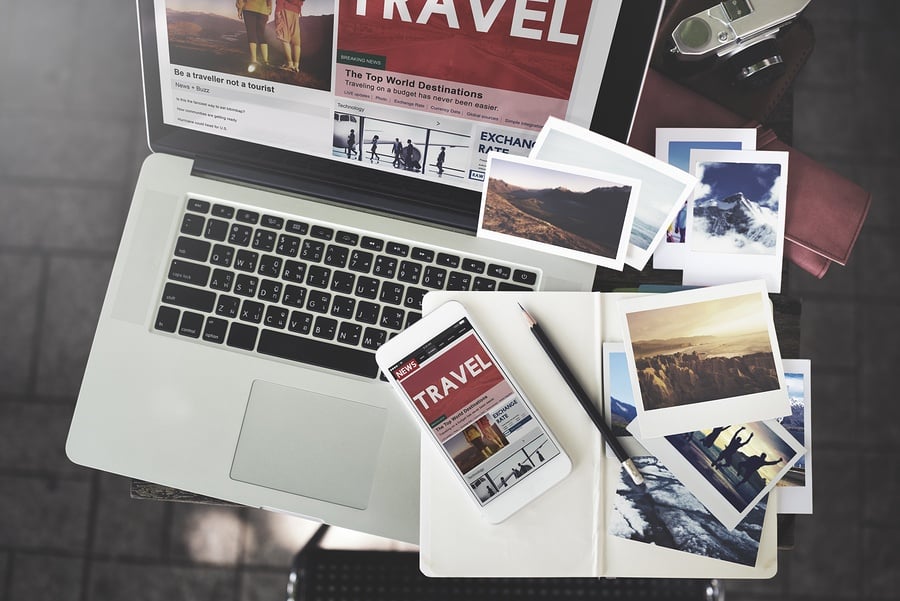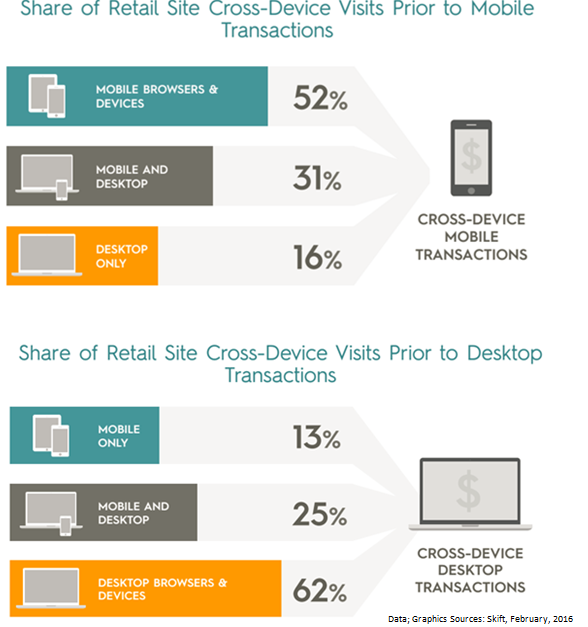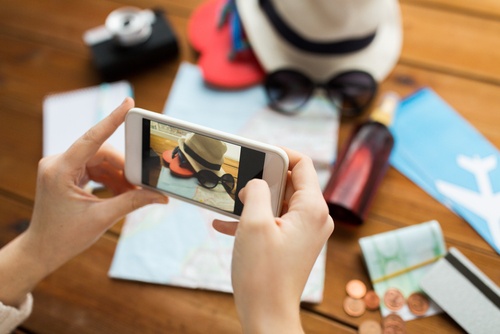The Importance of Social Media in Today’s Travel Industry
By Nick Ostdick on Apr 12, 2016 9:00:00 AM

 Travel is an inherently social act. Even if you’re traveling alone, whether for business or leisure, you’re not really alone - instead, you’re surrounded by scores of other travelers in airports, bus terminals, or hotel lobbies, most of whom are frequently checking their smart phones for the latest updates on Facebook or Twitter. Even if you’re not the one logging on, by extension you’re in greater company than you think.
Travel is an inherently social act. Even if you’re traveling alone, whether for business or leisure, you’re not really alone - instead, you’re surrounded by scores of other travelers in airports, bus terminals, or hotel lobbies, most of whom are frequently checking their smart phones for the latest updates on Facebook or Twitter. Even if you’re not the one logging on, by extension you’re in greater company than you think.
This increased level of connectivity via social media is no longer something industry analysts can write off as a fad or trend. Websites like Facebook, Twitter, Instagram, and Pinterest have not only revolutionized the way people communicate and interact, but they’ve also profoundly shifted how companies engage with and transact business with their customers. Opting for speed and flexibility, today’s travelers use social media platforms to research, review, recommend, and even purchase vacations or travel services and packages. TMCs, OTAs, and tour operators must leverage social media as a key tool in communicating and marketing to customers on a 24/7 basis.
Along with mobile capabilities, agility, transparency, and enhanced visibility across all points of the value chain is the name of the game in today’s travel industry landscape, and the use of social media is a crucial driver for travel companies to stimulate growth and differentiate themselves from the competition.
With that in mind, here are just a few ways social media has become an important fixture throughout the tourism industry.
Numbers Don’t Lie
Facebook currently has more than 1 billion daily active users. Twitter 320 million users. TripAdvisor 60 million. And those are just three of literally hundreds of social media websites and platforms today’s traveler has at his/her disposal, not counting other social media juggernauts like Instagram, Pinterest, LinkedIn, and others. Social media platforms and applications are where the modern traveler chooses to “live,” and travel companies who neglect social media strategies are failing to engage with a massive customer and market pool. Social media users share their travel experiences on these websites - they post photos, videos, links, and other pieces of content that are then shared by other users, and this cycle can repeat and spread like wildfire. Leveraging this potential to distribute special offers, notifications, updates, and other information about products and services can be a core driver in enhancing a travel company’s outreach without investing much in the way of resources and personnel.
Millennials
Millennials are perhaps the most sought-after demographic in today’s travel industry, yet they are also perhaps the most difficult to attract and target. They want individualized travel experiences that express their personality and taste, but they also demand affordability and flexibility in packaging, booking, and more. Part of what makes millennials difficult to reach is that they often avoid conventional channels of communication - advertisements in print, radio, and television - however millennials view social media as crucial to their professional and personal lives. A recent study of mobile and social media usage found that millennials check their smart phones or mobile devices an estimated 45 times per day, and that more than 80 percent cited using Facebook as an inspiration for future travel plans. Utilizing a robust social media strategy allows travel companies to directly engage in two-communication with this hard-to-pin-down demographic, and allows companies to craft clear, focussed messaging to reach this generation of travelers.
It’s important to remember millennials should not be viewed simply as leisure travelers who use social media as a way to share photos of their daily lives. In an increasingly connected, digital world, many millennials work for B2B, B2C, software, and logistics companies. Travel companies who use social media to reach millennials on a professional level - for example, imagine a supply chain planner discovering a Facebook post about a travel company’s new booking software and entering into a partnership with that travel company based on said post - stand to increase their growth and profitability by leveraging social media as more than a leisure-based platform.
Collaboration and Communication
Imagine Travel Software Company A Tweets about a new update to its booking and logistics software. This Tweet contains a link to a product information page on the company’s website complete with the software specs, testimonials, contact information, and more - pretty standard scenario, right? But then imagine a start-up OTA in search of a new booking solution stumbles across this Tweet, reaches out to Travel Company A as an interested customer, and cements a long-term relationship with Travel Company A. While this may sound like a dream-like situation, partnerships and collaborations like this are not uncommon via the myriad of available social media networks, and many companies have begun to view social media platforms and interactions as a method of nurturing leads and potential customers over a long period of time.
Social media also allows for Travel Company A and our start-up OTA to communicate in real-time about products and news within the travel industry, and to provide feedback and instantaneous market research by the reception and proliferation of a Tweet or Facebook update. In addition, Travel Company A and our start-up OTA can collaborate on directed messaging and marketing campaigns with very little overhead or up-front costs.
Combatting Disruptions
Let’s face it: disruptions are an inevitable part of the travel industry. Adverse weather conditions, natural disasters, political or regional unrest, mechanical breakdowns, or other variables result in travel delays and disruptions that can be harmful to a travel company’s reputation and severely hamper a company’s ability to handle the demands of altering travelers’ bookings and reservations. Facebook, Twitter, and other social media websites provide travel companies a clear channel to distribute information about flight delays or other travel impediments. In addition, travel companies can stay on-top of developing disruptions by using social media websites to monitor unfolding events and travelers’ reactions, responses, and needs during travel or supply breakdowns. Essentially, social media allows travel companies to maintain a ‘boots on the ground’ viewpoint even if they’re not physically at the scene of the disruption.
The Future of Social Media?
As you can see, the influence of social media on the travel industry cannot be overstated - while it may not have revolutionized the tourism industry, it’s certainly made travel companies reevaluate how they interact with customers, partners, vendors, and others. It’s difficult to predict what the future of social media in the travel industry may hold, but with instant messaging and video applications like SnapChat and others, it’s not out of the question to imagine a future when travel agencies, tour operators, and others within the travel industry communicate and work with customers or partners through these video and messaging apps.
Perhaps a travel company creates a real-time video advertisement or testimonial and publishes it using an application like SnapChat? Perhaps bookings and reservations will be aided or completed via these services? Whatever the case, it’s clear social media and the travel industry will be a lasting relationship.
Dive into the travel industry!
Explore useful insights and trends through our free eBooks now!
- travel technology (58)
- Travel Industry (49)
- travel agency (31)
- travel erp (31)
- travel trends (28)
- travel booking system (23)
- TINA (21)
- travel company (19)
- Tour Operator (18)
- Product updates (17)
- Travel Management Company (17)
- AIDA (15)
- TBS (15)
- dcs plus news (14)
- tour operator solution (14)
- travel website (14)
- travel erp system (13)
- Business Travel (12)
- Mobile App (12)
- Travel App (12)
- mid back office solution (12)
- trends (12)
- Industry Events (11)
- Mobile Technology (11)
- TMC (11)
- travel agents (11)
- erp (10)
- erp system (10)
- Corporate Travel (9)
- Tour Operators (9)
- Travel booking engines (9)
- dcs plus (9)
- online travel agency (9)
- travel agent (9)
- Mobile Bookings (8)
- travel (8)
- travel agencies (8)
- 2017 (7)
- Mobile Travel (7)
- travel business (7)
- travel software (7)
- Digital Technology (6)
- Insider (6)
- Millennials (6)
- Online booking systems (6)
- Travel Management Companies (6)
- process automation (6)
- travel companies (6)
- Big Data (5)
- Business Traveler (5)
- Partners interviews (5)
- Tour Operator Software (5)
- customer retention (5)
- travel agency technology (5)
- Booking engines (4)
- CSBT (4)
- Mobile Device (4)
- OTAs (4)
- Static databases (4)
- Tour Companies (4)
- Travel Policy (4)
- Travel booking systems (4)
- Travel suppliers (4)
- back office automation (4)
- millennial travelers (4)
- online travel (4)
- responsive travel website (4)
- technology (4)
- travel website conversion (4)
- 2016 (3)
- Content mapping (3)
- Databases (3)
- Demographics (3)
- Food and Adventure Tourism (3)
- Mobile Apps (3)
- Mobile travel apps (3)
- Travel Distribution Channels (3)
- Travel Management Software (3)
- Travel customers (3)
- Travel history (3)
- anniversary (3)
- automated processes (3)
- content matching (3)
- global travel industry (3)
- social media (3)
- travel agency workflow (3)
- travel back office (3)
- travel marketing (3)
- travel process automation (3)
- Advanced Booking Systems (2)
- B2B Travel Resellers (2)
- Bleisure (2)
- Branding (2)
- Business Process Automation (2)
- Business Travelers (2)
- Customer engagement (2)
- Financial Reporting (2)
- Food Tourism (2)
- Inbound Marketing (2)
- Infographic (2)
- Leisure Travel (2)
- Saas (2)
- Templates (2)
- Travel Costs (2)
- Travel bookings (2)
- Travel start-up (2)
- Travel website abandonment (2)
- WTM 2016 (2)
- abandoned travel bookings (2)
- corporate self booking tool (2)
- engagement marketing (2)
- internet booking engine (2)
- millennial traveler (2)
- new travel company (2)
- office (2)
- online reputation management (2)
- online travel reviews (2)
- reporting (2)
- software (2)
- start-up tips (2)
- travel agency management (2)
- travel agency website (2)
- travel experience (2)
- travel mobile app (2)
- travel packages (2)
- travel reservation system (2)
- travel system (2)
- travelers (2)
- web-based travel erp (2)
- 2020 (1)
- 360 Customer View (1)
- Advanced Accommodation Contract Management (1)
- Adventure travelers (1)
- Apps (1)
- B2B Reseller (1)
- B2B Resellers (1)
- B2C (1)
- BI Reporting (1)
- Budget traveler (1)
- Cancellations (1)
- Chat (1)
- Chinese millennial (1)
- Cloud (1)
- Cognitive computing (1)
- Comparison shopping (1)
- Conference (1)
- Contact matching (1)
- Content (1)
- Cruise (1)
- Culinary traveler (1)
- Customer relations (1)
- Digital Innovation (1)
- Digital Natives (1)
- Documents (1)
- Emerging market travelers (1)
- Emerging markets (1)
- Errors (1)
- Experimental travel (1)
- Financial Dashboard (1)
- Import rates (1)
- Instant messaging (1)
- Integrate with Accounting Software (1)
- Internet (1)
- Luxury traveler (1)
- Mobile Transaction (1)
- Mobile payments (1)
- NDC distribution (1)
- Operational Reporting (1)
- Reseller networks (1)
- Resellers (1)
- Response (1)
- Subagents Network (1)
- TINA Academy (1)
- TTE (1)
- Travel Reseller Network (1)
- Travel Revenue Management (1)
- Travel booking problems (1)
- Travel finance reporting (1)
- Travel stats (1)
- WTM (1)
- abandonment (1)
- accomodations (1)
- advanced reporting (1)
- airline direct connect technology (1)
- ancillary services (1)
- cloud computing (1)
- collection (1)
- collection challenges (1)
- common data model (1)
- conversion rates (1)
- cost control (1)
- credo ventures capital invests in dcs plus (1)
- customer reviews (1)
- data analysis (1)
- dcs plus credo investment (1)
- dcs plus credo ventures (1)
- deloitte technology fast 500 EMEA (1)
- digital transformation (1)
- e-invoicing KSA (1)
- email marketing (1)
- email marketing for OTAs (1)
- erp e-invoicing (1)
- lost travel bookings (1)
- modern travel agencies (1)
- networks (1)
- new features (1)
- offers (1)
- online customer review (1)
- online reputation (1)
- online travel agencies (1)
- risk management (1)
- sales (1)
- senior travelers (1)
- shopping baskets (1)
- shopping carts (1)
- social network (1)
- standardized processes (1)
- static content (1)
- travel SaaS (1)
- travel account services (1)
- travel agency customers (1)
- travel agency profitability (1)
- travel analytics (1)
- travel blog (1)
- travel planning (1)
- travel reviews (1)
- travel shopping carts (1)
- travel software for agencies (1)
- travel software system (1)
- travel technology europe (1)
- travlist smart mobile app (1)
- trend (1)
- trusted adviser (1)
- trusted advisor (1)
- upsell functionality (1)
- vouchers (1)
- website traffic (1)
- zatca (1)
Subscribe by email
You May Also Like
These Related Stories

Digital: Rocket Fuel for the Travel Industry

Mobile Transactions & the Travel Industry: Infographics for 2016


No Comments Yet
Let us know what you think